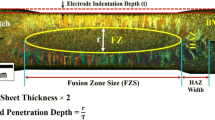Abstract
Metallic coatings have been widely used for hot-stamped boron steel in automotive applications. Surface coating in hot-stamped boron steels has improved corrosion resistance. However, a thick coating layer degrades resistance spot weldability. In the case of a Zn-coated hot-stamped boron steel, the high contact resistance and material stiffness with low vaporization temperature of the alloyed layers result in a narrow current passage at the faying surface. Expulsion occurs at low current due to rapid heat development, resulting in a narrow weld current range. The pulsed current can control the heat input by applying a fast cool time during welding to improve the mechanical properties of the joint and acceptable current range. In this study, Zn-coated hot-stamped steels were resistance spot welded using various pulse current procedures, and welding condition was optimized via three pulsed current steps. Step 1: Contact area was controlled without nugget formation. Step 2: Nugget growth was minimized and contact area was maximized. Step 3: The maximum acceptable current range and nugget diameter were achieved. These welding conditions improved the acceptable current range and mechanical properties of spot welds due to increased spot weld size.
Similar content being viewed by others
References
Advanced High-Strength Steel (AHSS): Applications Guidelines, International Iron & Steel Institute, Committee on Automotive Applications (2005).
V. H. Baltazar Hernandez, M. L. Kuntz, M. I. Khan and Y. Zhou, Influence of microstructure and weld size on the mechanical behaviour of dissimilar AHSS resistance spot welds, Science and Technology of Welding and Joining, 13 (2008) 769–776.
M. Merklein, J. Lechler and T. Stoehr, Characterization of tribological and thermal properties of metallic coatings for hot stamping boron-manganese steels, Proc. of the 7th International Conference Coatings in Manufacturing Engineering, Greece, 10 (2008) 219–227.
D.-Y. Choi and Y.-G. Kim, Trend of joining technology for automotive sheet steels, J. KWJS, 27 (2) (2009) 7–12.
T.-K. Han, K.-Y. Lee and J.-S. Kim, Recent developments and weldability of advanced high strength steels for automotive applications, J. KWJS, 21 (2) (2009) 13–18.
H. Karbasian and A. E. Tekkaya, A review on hot stamping, Journal of Materials Processing Technology, 210 (2010) 2103–2118.
H. S. Hwang and H. C. Kwon, In-process monitoring of micro resistance spot weld quality using accelerometer, J. KWJS, 29 (1) 115–122.
D. W. Fan and B. C. De Cooman, State-of-the-knowledge on coating systems for hot-stamped parts, Steel Research Int., 83 (5) (2012) 412–413.
J. Kondratiuk, P. Kuhn, E. Labrenz and C. Bischoff, Zinc coatings for hot sheet metal forming: Comparison of phase evolution and microstructure. during heat treatment, Surface and Coatings Technology, 205 (17–18. (2011) 4141–4153.
C.-W. Ji, I. Jo, H. Lee, I.-D. Choi, Y. D. Kim and Y.-D. Park, Effects of surface coating on weld growth of resistance spot-welded hot-stamped boron steels, Journal of Mechanical Science and Technology, 28 (11) (2014) 4761–4769.
I. S. Hwang, M. J. Kang and D. C. Kim, Expulsion reduction in resistance spot welding by controlling of welding current waveform, Procedia Engineering, 10 (2011) 2775.
D. C. Saha, C. W. Ji and Y. D. Park, Coating behaviour and nugget formation during resistance welding of hot forming steels, Science and Technology of Welding and Joining, 20 (8) (2015) 708–720.
C.-W. Ji, I. Choi, Y. D. Kim and Y.-D. Park, Study on coating melting behavior on weld growth mechanism for Al-Si coated hot-stamped boron steels in resistance spot welding, Korean J. Met. Mater., 52 (11) (2014) 931–941.
ISO standard, ISO 18278-2 Resistance welding —weldability, part 2: Alternative procedures for the assessment of sheet steels for spot welding (2004).
A. Terajima, T. Horino, F. Ikuta, Y. Misaka, K. Kawasaki, H. Murakawa, K. Hiraoka and K. Nakata, Improving weld strength with HF post-heating process in resistance spot welding of ultra-high strength steel sheets, IIW International Conference, IIW2015-15.
G. P. Kelkar, Why Use Multiple-impulse Resistance Welding?, Published in Practical Welding (2004).
Author information
Authors and Affiliations
Corresponding author
Additional information
Recommended by Associate Editor Tae June Kang
Jooyong Cheon is currently a researcher at the Ulsan Regional Division of Korea Institute of Industrial Technology in Ulsan, Korea. His current research interests spot welding and Arc welding.
Changwook Ji received his Ph.D. from the Pusan National University in Busan, Korea. He is currently a Senior Researcher at the Ulsan Regional Division of Koreainstitute of Industrial Technology in Ulsan, Korea.
Rights and permissions
About this article
Cite this article
Cheon, J.Y., Vijayan, V., Murgun, S. et al. Optimization of pulsed current in resistance spot welding of Zn-coated hot-stamped boron steels. J Mech Sci Technol 33, 1615–1621 (2019). https://doi.org/10.1007/s12206-019-0313-2
Received:
Revised:
Accepted:
Published:
Issue Date:
DOI: https://doi.org/10.1007/s12206-019-0313-2




